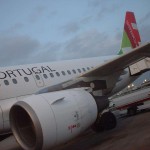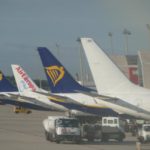Northwest Airlines Corporation (OTC: NWACQ.PK) announced that it and certain of its subsidiaries have filed their joint Chapter 11 plan of reorganization with the United States Bankruptcy Court for the Southern District of New York, which is overseeing its reorganization.
EAGAN, Minn –The plan provides for the treatment of claims of creditors, the implementation of agreements with key labor groups, lenders and suppliers, as well as the raising of new equity capital for Northwest.
Commenting on the plan, Doug Steenland, Northwest Airlines president and chief executive officer, said, “The filing of our plan of reorganization is a key milestone in our ongoing restructuring efforts and begins Northwest’s emergence from Chapter 11 protection.”
“Over the past 16 months, we have achieved the three key objectives we set for our restructuring: we have removed $2.4 billion in annual costs from the business, we have restructured our fleet and entered into new aircraft purchase agreements, and we have significantly strengthened our balance sheet. We remain on track to report a pre-tax profit for the full year 2006.”
Steenland continued, “By returning to profitability, we will enable our employees, whose sacrifices have been essential to the successful reorganization of Northwest, to share in its success. For our employees, a healthy Northwest will ensure a future of job security, pension and retirement benefits, profit-sharing payments and access to a valuable claim.”
[GADS_NEWS]RESTRUCTURING PROGRESS
Discussing the airline’s restructuring milestones to date, Steenland said, “We have moved through the bankruptcy process quickly because of our success in addressing key cost and revenue issues including labor costs and pensions, new agreements with key suppliers, restructuring the Northwest fleet, and substantially reducing debt.”
“Key to our successful restructuring efforts to date are the permanent labor savings agreements we have reached with the International Association of Machinists and Aerospace Workers (IAM), the Air Line Pilots Association (ALPA), the Aircraft Mechanics Fraternal Association (AMFA), the Aircraft Technical Support Association (ATSA), the Transport Workers Union of America (TWU), and the Northwest Airlines Meteorologists Association (NAMA), which have helped us realize the $1.4 billion in annual labor savings we required.”
Steenland continued, “Recognizing the importance of pensions to our employees, we worked together over the past several years with our union leadership and the Congress on a carefully crafted solution, the Pension Protection Act, which has preserved pension benefits for the 73,000 Northwest pension plan participants. We have always believed saving our pension plans was the right thing to do for our valued employees, and despite the many obstacles we faced along the way, we did not waver from this commitment.”
“To ensure that Northwest has an efficient and comfortable fleet, we reaffirmed purchase agreements with Airbus, Boeing, GE Aircraft Engines and Pratt & Whitney that allow us to continue to modernize our long-range fleet with A330 and 787 aircraft. We also negotiated additional purchase agreements with Bombardier and Embraer for new, dual-class regional jetliners that will improve our domestic product.”
Discussing the airline’s regional aircraft strategy, Steenland said, “We have nearly completed agreements with our three Airlink partners – Pinnacle, Mesaba and Compass – which will be operating the regional aircraft that will provide convenient connections to Northwest’s global network through its three domestic hubs.”
“In addition, our operational costs were improved by reshaping our maintenance organization, which resulted in greatly improved economics while continuing Northwest’s historic operational reliability.”
Speaking to the restructured balance sheet, Steenland said, “We have completed a $975 million refinancing of existing bank obligations at more favorable terms while gaining access to $250 million in incremental liquidity. Our new facility can be converted to permanent exit financing, securing the debt financing Northwest needs to emerge from Chapter 11 protection.”
“The completion of this refinancing clearly demonstrated that our key stakeholders in the capital markets recognized Northwest’s progress towards its restructuring goal of positive cash flow and sustained profitability.”
Steenland added that, “Reversing $4.2 billion in losses since early 2001 was not an easy task, but one that was essential to the future of the airline. Through our many restructuring actions, we expect to report a significant year-over-year improvement in pre-tax earnings from 2005 to 2006.”
PLAN HIGHLIGHTS
Creditors
The plan proposes to restructure Northwest’s balance sheet through the elimination of all pre-petition unsecured debt. In exchange for their claims, unsecured creditors will receive common stock of the reorganized Northwest Airlines Corporation, and the right to purchase additional common stock in a rights offering. Terms of a rights offering will be provided at a later time. Unsecured creditors whose claims are guaranteed by certain other Northwest entities will receive an additional distribution of common stock on their claims.
Because all unsecured creditor claims will not be satisfied in full, the pre-petition equity holders’ interests in Northwest’s common and preferred stock will be cancelled, and those holders will not receive a distribution.
Agreements
The plan will implement the favorably renegotiated aircraft purchase agreements with Airbus, Boeing, Bombardier, GE Aircraft Engines and Pratt & Whitney, and new aircraft purchase agreements with Embraer and Bombardier. The plan will adopt and put in place the restructured lease and debt obligations for Northwest’s aircraft fleet and airports and other facilities. All of these agreements will provide substantial cost savings to Northwest.
In addition, the plan provides for the assumption of the company’s ratified collective bargaining agreements with each of its labor groups, except for its flight attendants. Each labor group with a ratified collective bargaining agreement has a negotiated claim as part of that agreement. The Association of Flight Attendants does not have an approved claim because it does not yet have a ratified collective bargaining agreement. Should the flight attendants enter into a ratified agreement prior to Northwest finalizing its plan of reorganization, an approved claim would also be available to them.
Equity/Debt
As noted above, the plan provides for the option to raise exit equity financing via an equity rights offering. The plan also anticipates that Northwest may supplement the rights offering by obtaining additional new equity capital from one or more private equity investors.
Northwest will have the option to convert its existing debtor-in-possession financing upon its emergence from bankruptcy into an exit financing facility consisting of a $175 million revolving credit facility and a $1.05 billion term loan, including a $75 million letter of credit facility, each of which has a maturity date of August 2013. Northwest also may elect to proceed with alternative exit financing if more attractive terms than those under the existing facility can be obtained.
Timing
The bankruptcy court has granted Northwest an extension until February 15, 2007 to file a disclosure statement providing additional information and detail regarding the plan. After approval by the court, Northwest will distribute the plan and disclosure statement to its creditors and begin a period of solicitation of creditors for acceptance of the plan. Northwest expects to emerge from Chapter 11 during the second quarter of 2007.
FORWARD-LOOKING STATEMENTS
Certain of the statements made in this news release are forward-looking and are based upon information available to the Company on the date hereof. The Company, through its management, may also from time to time make oral forward-looking statements. In connection with the “safe harbor” provisions of the Private Securities Litigation Reform Act of 1995, the Company is hereby identifying important factors that could cause actual results to differ materially from those contained in any forward-looking statement made by or on behalf of the Company. Any such statement is qualified by reference to the following cautionary statements.
The Company believes that the material risks and uncertainties that could affect the outlook of an airline operating under Chapter 11 and in a global economy include, among others, the ability of the Company to continue as a going concern, the ability of the Company to obtain and maintain any necessary financing for operations and other purposes, the ability of the Company to maintain adequate liquidity, the ability of the Company to absorb escalating fuel costs, the Company’s ability to obtain court approval with respect to motions in the Chapter 11 proceedings prosecuted by it from time to time, the ability of the Company to develop, confirm and consummate a plan of reorganization with respect to its Chapter 11 proceedings, risks associated with third parties seeking and obtaining court approval to terminate or shorten the exclusivity period for the Company to propose and confirm a plan of reorganization, to appoint a Chapter 11 trustee or to convert the cases to Chapter 7 cases, the ability of the Company to obtain and maintain normal terms with vendors and service providers, the Company’s ability to maintain contracts that are critical to its operations, the ability of the Company to realize assets and satisfy liabilities without substantial adjustments and/or changes in ownership, the potential adverse impact of the Chapter 11 proceedings on the Company’s liquidity or results of operations, the ability of the Company to operate pursuant to the terms of its financing facilities (particularly the related financial covenants), the ability of the Company to attract, motivate and/or retain key executives and associates, the future level of air travel demand, the Company’s future passenger traffic and yields, the airline industry pricing environment, increased costs for security, the cost and availability of aviation insurance coverage and war risk coverage, the general economic condition of the United States and other regions of the world, the price and availability of jet fuel, the war in Iraq, the possibility of additional terrorist attacks or the fear of such attacks, concerns about SARS, Avian flu or other influenza or contagious illnesses, labor strikes, work disruptions, labor negotiations both at other carriers and the Company, low cost carrier expansion, capacity decisions of other carriers, actions of the U.S. and foreign governments, foreign currency exchange rate fluctuations, inflation and other factors discussed herein. Additional information with respect to these factors and other events that could cause differences between forward-looking statements and future actual results is contained in “Item 2. Management’s Discussion and Analysis of Financial Condition and Results of Operations” of Form 10-Q for the quarter ended September 30, 2006 and “Item 1. Business – Risk Factors Related to Northwest and the Airline Industry” in the Company’s Annual Report on Form 10-K for 2005.
Developments in any of these areas, as well as other risks and uncertainties detailed from time to time in the Company’s Securities and Exchange Commission filings, could cause the Company’s results to differ from results that have been or may be projected by or on behalf of the Company. The Company undertakes no obligation to publicly update or revise any forward-looking statements, whether as a result of new information, future events or otherwise. These statements deal with the Company’s expectations about the future and are subject to a number of factors that could cause actual results to differ materially from the Company’s expectations. All subsequent written or oral forward-looking statements attributable to the Company, or persons acting on behalf of the Company, are expressly qualified in their entirety by the factors described above.
Northwest Airlines is one of the world’s largest airlines with hubs at Detroit, Minneapolis/St. Paul, Memphis, Tokyo and Amsterdam, and approximately 1,400 daily departures. Northwest is a member of SkyTeam, an airline alliance that offers customers one of the world’s most extensive global networks. Northwest and its travel partners serve more than 900 cities in excess of 160 countries on six continents.
###





